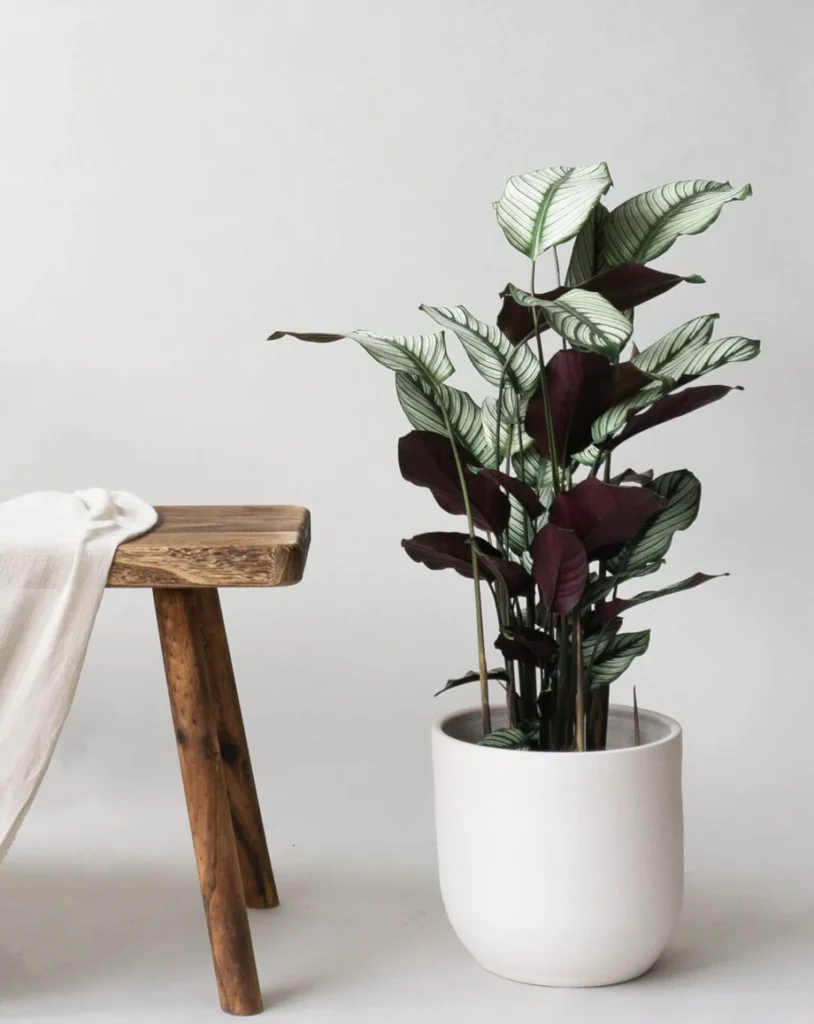Calathea Whitestar is a stunning tropical plant known for its beautiful white-striped leaves contrasting with a deep green background. It is a member of the Marantaceae family and is native to the rainforests of Brazil.
The plant is valued for its striking appearance and unique ability to move its leaves in response to changes in light and temperature. During the day, its leaves are spread out wide to absorb as much light as possible, and at night, they fold up to conserve energy.
Calathea Whitestar is a relatively low-maintenance plant that thrives in warm and humid conditions. It is often grown as a houseplant and can add a touch of natural beauty to any indoor space.
With proper care, Calathea Whitestar can grow up to two feet tall and wide, making it an excellent choice for those who want to add a tropical feel to their home or office.

Characteristics of Calathea Whitestar
Calathea Whitestar has several distinct characteristics that make it a popular houseplant:
- Leaves: The plant has large, paddle-shaped deep green leaves with striking white stripes. The underside of the leaves is a beautiful shade of purple.
- Movement: Calathea Whitestar has a unique ability to move its leaves in response to changes in light and temperature. Its leaves fold up at night and spread out during the day.
- Size: The plant can grow up to two feet tall and wide, making it an excellent choice for those who want a more significant houseplant.
- Care: Calathea Whitestar is a relatively low-maintenance plant that requires bright, indirect light and high humidity to thrive. It prefers well-draining soil and should be watered regularly but not overwatered.
- Air Purifier: Like many houseplants, Calathea Whitestar can help to purify the air by removing toxins such as formaldehyde and benzene.
- Pet-friendly: Calathea Whitestar is non-toxic to pets, making it an excellent choice for pet owners who want a safe houseplant for their furry friends.
Overall, Calathea Whitestar is a beautiful and unique plant that will add a touch of tropical elegance to any indoor space.
Calathea Whitestar Complete Care Guide
Here is a complete care guide for Calathea Whitestar:
Light Requirements
Calathea Whitestar prefers bright, indirect light. Direct sunlight can scorch its leaves, so placing it near a window with filtered light or in a bright, shaded area of your home is best.
Temperature Requirements
The plant prefers warm temperatures between 65-80°F (18-27°C). It is sensitive to cold drafts and should be kept from air conditioning vents.
Humidity Requirements
Calathea Whitestar requires high humidity to thrive. You can increase humidity levels by placing a humidifier near the plant or grouping it with other plants.
Alternatively, you can mist the leaves regularly with room-temperature water.
Watering Requirements
Calathea Whitestar likes to be kept moist but not soggy. Water the plant when the top inch of soil is dry, but do not let it sit in standing water as this can cause root rot.
The watering frequency will depend on your home’s humidity and temperature.
Soil Requirements
The plant prefers well-draining soil that is rich in organic matter. A mixture of peat moss, perlite, and sand works well.
Fertilizer Requirements
Calathea Whitestar benefits from regular fertilization during the growing season (spring and summer). Use a balanced fertilizer every 2-3 weeks.
Pruning Requirements
Prune any yellow or damaged leaves as soon as possible to prevent disease. You can also trim any leggy or overgrown stems to encourage fuller growth.
By following these care guidelines, your Calathea Whitestar should thrive and continue to add beauty to your indoor space.

Propagation of Calathea Whitestar
Calathea Whitestar can be propagated through division. Here’s how to propagate Calathea Whitestar:
- Choose a healthy, mature plant with multiple stems.
- Carefully remove the plant from its pot and gently separate the roots, ensuring each division has at least one stem and healthy roots.
- If the plant has a lot of soil stuck to its roots, you can gently rinse them off with room-temperature water.
- Plant each division in its pot with fresh soil. The pot should be about 1-2 inches larger than the root ball.
- Water the newly planted divisions and keep them in a warm, humid location with bright, indirect light. Cover the plant with a plastic bag or cloche to increase humidity and promote growth.
- Keep the soil moist but not soggy, and avoid direct sunlight, which can scorch the leaves.
- Once the new divisions have established roots and started to grow fresh leaves, you can treat them like mature plants and follow the care guidelines mentioned earlier.
Propagation is best done during the spring or summer when the plant is actively growing. Following these steps, you can create new Calathea Whitestar plants to share with friends or add to your indoor garden.
Also Check: Calathea Louisae 101: The Definitive Guide to Care and Propagation
Common Problems & Solutions
Like all houseplants, Calathea Whitestar can encounter some common problems. Here are some issues you may encounter and how to address them:
- Curling or crispy leaves: This can indicate low humidity or underwatering. Increase humidity levels and make sure you are watering the plant enough.
- Yellow leaves: Yellowing leaves can be a sign of overwatering or root rot. Allow the soil to dry out slightly before watering, and make sure the plant is not sitting in standing water.
- Brown leaf edges: This can be caused by too much direct sunlight or dry air. Move the plant to a shadier location and increase humidity levels.
- Pests: Calathea Whitestar can be susceptible to spider mites and mealybugs. Treat any infestations with insecticidal soap or neem oil.
- Leggy growth: Leggy growth can be caused by low light levels. Move the plant to a brighter location or supplement it with artificial light.
- Fungal diseases: Overwatering or high humidity levels can lead to fungal infections such as root rot or leaf spot. Ensure the plant has adequate drainage and avoid getting water on the leaves.
By addressing these common problems, you can keep your Calathea Whitestar healthy and beautiful.
Conclusion
In conclusion, Calathea Whitestar is a beautiful and unique houseplant that can add interest and color to your indoor space. It has distinctive foliage with white and green stripes and prefers warm, humid environments with bright, indirect light.
By following simple care guidelines, such as regular watering, fertilization, and monitoring for pests, you can keep your Calathea Whitestar healthy and thriving.
If you want to add a touch of tropical elegance to your home, consider bringing a Calathea Whitestar into your collection.
Also, Check: Calathea Crocata: Care Guide and Propagation Tips
Frequently Asked Questions about Calathea Whitestar
How often should I water Calathea Whitestar?
Calathea Whitestar prefers consistently moist soil, but it’s important not to overwater it. Water the plant when the top inch of soil feels dry.
How much light does Calathea Whitestar need?
Calathea Whitestar prefers bright, indirect light. Avoid direct sunlight, which can scorch the leaves.
How often should I fertilize Calathea Whitestar?
Fertilize the plant monthly during the growing season (spring and summer) with a balanced, water-soluble fertilizer.
<h3 class="wp-block-heading" id="h-how-can-i-increase-humidity-for-calathea-whitestar">How can I increase humidity for Calathea Whitestar?You can increase humidity by misting the leaves with water, placing a tray near the plant, or using a humidifier.
Can I prune Calathea Whitestar?
Yes, you can prune Calathea Whitestar to control its size or shape. Use sharp, clean scissors and make clean cuts just above a leaf node.
Can Calathea Whitestar be grown outdoors?
Calathea Whitestar is a tropical plant that prefers warm, humid environments. It is not frost-tolerant and should be kept indoors year-round.
<h3 class="wp-block-heading" id="h-is-calathea-whitestar-toxic">Is Calathea Whitestar toxic?Calathea Whitestar is not considered toxic to humans or pets, according to the American Society for the Prevention of Cruelty to Animals (ASPCA). This means that if ingested, it is unlikely to cause serious harm to your furry friends or children. However, it’s always a good idea to keep plants out of reach of pets or children, as ingesting any plant material can cause minor gastrointestinal upset. Additionally, some people may be sensitive to the sap or foliage of the plant, so it’s a good idea to wear gloves when handling it.
